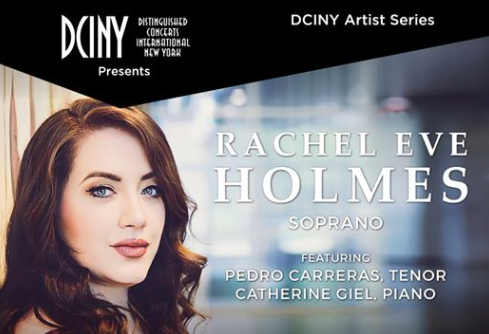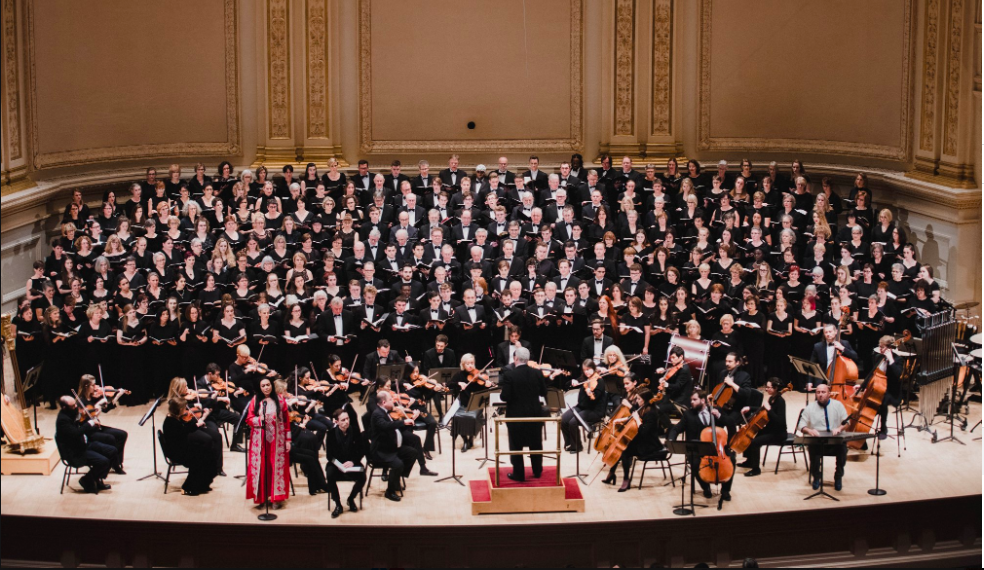Jonathan Griffith, Artistic Director and Principal Conductor
Sir Karl Jenkins, CBE, Composer-in-Residence
Iestyn Davies, countertenor; Baidar Al Basri, ethnic music vocalist; Mikhail Veselov, cello; Claudia Chapa, mezzo-soprano; Hussein Janmohamed, Call to Prayers reciter
Special Guest: Jeff Spurgeon, WQXR Radio Personality
Distinguished Concerts Orchestra; Distinguished Concerts Singers international
Stern Auditorium at Carnegie Hall, New York, NY
January 20, 2020
Sir Karl Jenkins (born 1944) is a Welsh composer who has been active in many fields of composition including rock, jazz, and advertising, as well as “serious” music. This program featured two of his major works, each of which consists of thirteen parts. The evening began with the North American premiere and, internationally, the second performance, of his Miserere: Songs of Mercy and Redemption. By contrast, the other work, The Armed Man: A Mass for Peace, is twenty years old and so popular, we were told, that it has been performed an average of twice a week ever since it was composed!
The size of Distinguished Concerts Singers International varies from performance to performance, but it seemed that on this occasion there were at least 150 to 200 singers onstage, and it was glorious to hear such a powerful vocal ensemble in this wonderful hall! The Distinguished Concerts Orchestra, founded in 2008 by Dr. Jonathan Griffith, varies from being a large group, in the Miserere, to a huge ensemble, such as filled the stage during The Armed Man. As with the chorus, the orchestra and the soloists, including a trumpeter who played from the Dress Circle in one movement of The Armed Man, were all excellent. (Unfortunately I could not find his name in the program.)
Some relevant words from the program notes about the Miserere by the composer: “Miserere: Songs of Mercy and Redemption is dedicated to all who have suffered during the tragic conflicts of the Middle East over the last 70 years. As we are only too well aware, the violence, horror and destruction have not been limited to that geo-political area…Miserere is the Latin imperative for ‘have mercy’ and is often used as a title for Psalm 51, of which the opening words are “Miserere mei, Deus” (Have mercy upon me, O God). Many composers have set this psalm to music…”
This work began with the Principium, featuring a solo by the wonderful cellist Mikhail Veselov, and evocative vocalizations by the ethnic vocal soloist Baidar Al Basri. Most of the vocal solos after that were by the excellent countertenor Iestyn Davies. The second movement, Miserere mei, Deum, was soothing and consoling, more “western sounding” than the first movement. The Ubi Caritas was warm and comforting, and the Sacramentum featured an eloquent cello solo. The sixth movement, which grew out of a unison, was based on the hymn, “When I Survey the Wondrous Cross” and had a powerful a cappella choral section. The eighth movement, Hymnus: Locus iste ,was more adventurous harmonically than what had come before, with interesting pauses between phrases. Praise, Joy and Gladness, the ninth movement, had a lively, different ethos, with perhaps an African influence, and great enthusiasm. Canendo, the tenth movement, was luxuriantly slow, a contemplation of beauty. The eleventh movement, Eli Jenkins’ Prayer and Epilogue, had a wonderfully big sound from the a cappella chorus, to which a small string ensemble was later added. Rahma (Mercy), the twelfth movement, was all but shouted out in Arabic, Hebrew, Greek and Aramaic, and featured a strong beat, a Middle Eastern flavor, and chromaticism. Contemplation and Redemption, the final movement was, in part, warm and calm, yet also somewhat edgy, with still unresolved emotional tension. The end felt like a benediction. There followed a standing ovation.
Guy Wilson has written program notes for The Armed Man: A Mass For Peace, which is clearly a classic of this type of anti-war repertoire. To quote Mr. Wilson: “The Armed Man: A Mass For Peace is the result of a special millennial commission from the Royal Armouries, and the latest in a six century-old tradition of ‘Armed Man’ masses that take the 15th century French song, L’Homme Armé as their starting point. The theme that the Armed Man must be feared, which is the message of the song, seemed painfully relevant to the 20th century and so the idea was born to commission a modern Armed Man Mass…The Armed Man, A Mass For Peace, received its world premiere in April 2000 at London’s Royal Albert Hall. In a rapturous performance, by turns visceral and ethereal, the Mass was ‘a fire bomb of orchestral and human voices’ (according to the London Times) and drew ‘prolonged shouts of approval from the audience’ (according to the Independent).” Before it was performed there was a brief onstage discussion with Sir Karl, Maestro Griffith, and Jeff Spurgeon from the radio station WQXR
Screened high above the orchestra and chorus as we heard this sixty-three minute musical work, focusing on the tragedies of war, was the film, The Armed Man. The film includes video of practically every known horror of the 20th century, including Nazis marching, war scenes, the aftermath of atrocities, the destruction of the World Trade Center, and touching scenes of relatives taking leave of their soldier sons, husbands, and fathers departing for battle. It was not clear to me if the film is usually shown together with this immense musical composition. People will have differing opinions on multi-media presentations. I could not help but wonder if encountering both at the same time may be overload, as the combined effect can all but push one over the edge emotionally. Does the film perhaps distract from the music, or the other way around? This may be a minority opinion, but I think I would prefer to hear/see them separately. Certainly, the musical score is on a monumental level.
There was great energy and enthusiasm in the first movement, which cheered me until I remembered the point of it was glorifying war. Following the Muslim call to prayer (Adhaan) came the somber Kyrie. The fourth movement, Save Me From Bloody Men, based on Psalm 56, had the male choral voices a cappella in a quasi-recitativo. The fifth movement, Sanctus, featured the chorus and brass responding to each other with ongoing drums at the same time. In this movement the orchestra made such a gigantic sound that the chorus was, at times, all but drowned out. The Hymn Before Action was dramatic and ominous. In the eighth movement, Angry Flames, mezzo-soprano Claudia Chapa declaimed against the brass, and there were choral “comments.” Her voice has particularly fine low notes. The ninth movement, Torches, had sonic eruptions, a quieter choral section, and then an explosion on the last word. The mood of the tenth movement, Agnus Dei , was one of resignation. Part of its loveliness reminded me of the Fauré Requiem. Now the Guns Have Stopped featured a major mezzo-soprano solo and tense harmonies, as if the ravages of war were still very much present, rather than past tense. The Benedictus, with a beautiful cello solo, was followed by the final movement, Better Is Peace. The big surprise, for one not familiar with this work, was that its theme was the same as that of the first movement, but here the music clamored, with equal strength, for peace, as it before had endorsed war. Brilliant! The last part of this final movement was based on a Biblical passage from Revelation. It was peaceful and chorale-like, and served as an Amen.
The composer and performers were greeted at the conclusion with great warmth and a standing ovation from the large audience.
by Donald Isler for New York Concert Review; New York, NY





